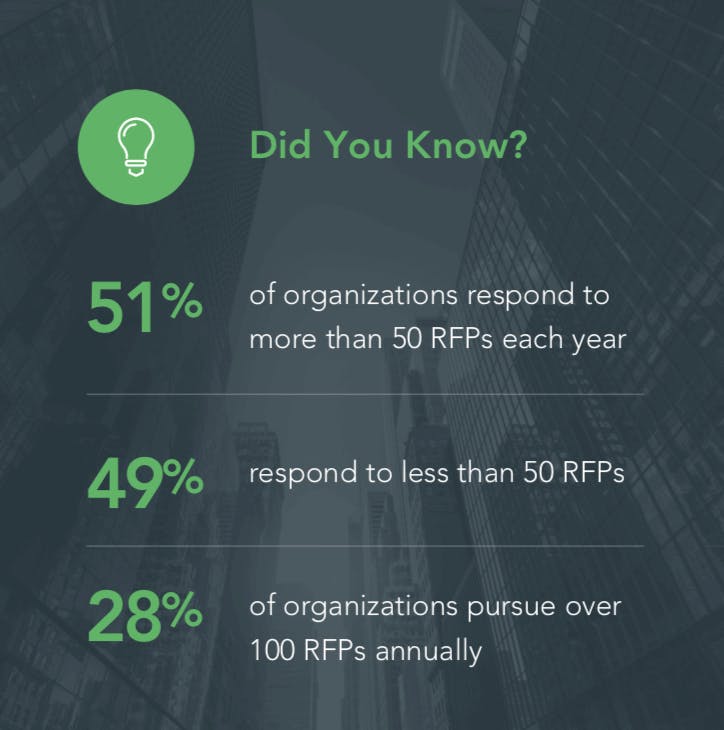We won’t sugarcoat this…losing a request for proposal is never a fun time. You and your team, many who work in multiple departments at your organization, put a lot of time and energy into crafting your RFP responses. You lose an important account in Q4 that could have helped you make your year.
At the end of the day, losing an RFP is kind of a bummer. However, as we experience in life, lessons can always be learned.
Jeffrey Davis, writing in Psychology Today, has these words of wisdom to share: “What matters is being able to delineate the reasons we’ve failed, and instead of taking the rejection personally, making it useful. If it isn’t useful, then it has to be left behind.”
On that note, let’s learn a few lessons after losing a request for proposal—along with some motivation to help you move forward and increase your win rate potential next time.
You just lost a huge RFP…Now what?
Step one: Breathe before you do anything else. You need to compose yourself, then proceed with sharing the news with other team members or responding to the prospect. For moral support, gain quick inspiration from famous “failures” who never quit:
- Albert Einstein
- Michael Jordan
- J.K. Rowling
- Thomas Edison
- Vincent Van Gogh
- Oprah Winfrey
- Steve Jobs
- Etc., etc., etc.
The one question you’re probably saying over and over again is: Why? Why didn’t we win? Why did they pick those [insert competitor nickname] over us?
Quite often it isn’t clear why your proposal didn’t succeed. Your product or service might be above and beyond your competitors. Yet somehow they’re celebrating the deal they just landed while you’re crying in the corner of the parking lot, wondering where it all went wrong.
A discreet call to your key contact at the organization may give some clarity as to why they chose your competitor over you. Use caution with this tactic, as they will likely give some rehearsed speech riddled with vague generalities that don’t help you at all. Then, you just end up spending time on an awkward phone call together. No good, right?
Which is why a classy email is your best move. We created several RFP response specific email templates for you to copy and send. Because we know responding to RFPs isn’t always about winning, you can use this email template the next time you need to have that tough conversation with a prospect…
RFP response email: Send after losing RFP
Hi [first name] –
Thank you for the update. I am surprised by this result as I remember specifically how well the demo went with your team, and the excellent fit between [Company] and [RFPIO].
I absolutely respect your decision, and I only ask for some additional feedback so I can understand how [RFPIO] can continue to improve. Let’s schedule a few minutes to chat, so I can better understand the specifics you were looking for. Any feedback I can glean in this scenario is very valuable.
Thank you very much,
Konnor
The goal is to lose gracefully. Equally important is to demonstrate complete confidence in your solution until the bitter end. You never know—this deal may come back around one day.
Hold a post-mortem to analyze your RFP loss
A “post-mortem” sounds dreary, but having a dedicated pow-wow after losing a request for proposal allows your team some time to work together for the sake of improvement. The idea here is that you will find some gaps and opportunities in your process—or within the RFP response content itself.
In a post-mortem session, use constructive criticism and don’t turn against each other. “Where can we improve?” is a better mindset than “Whose fault is it?”
A post-mortem certainly doesn’t need to happen after every single RFP. To stay consistent, schedule these meetings ahead of time at a cadence that makes sense for your organization. If you send over 100 RFPs annually like 28% of organizations, analyze your RFP response process once a month. A quarterly post-mortem might be more reasonable if you respond to 50 RFPs a year.

Another option is to hold a post-mortem after losing a key business opportunity. This strategy is more reactive and should be held in addition to your regularly scheduled post-mortems. Everyone is busy, so don’t spring post-mortems on your team too much or they will lose their effectiveness. Your team will not be as engaged, or they may find ways to skip attending in favor of other priorities.
Once your team is together, identify the stage where the proposal was rejected. If your RFP made it to the last two or three stages, that’s considered a good performance as most proposals don’t reach the final pitching stage. You probably only need to tweak your RFP responses slightly to get more wins in the future.
Let’s look at the main reasons why RFPs don’t make the cut, so you can leave your post-mortem with an action plan.
Ways to improve your RFPs to land your next deal
1. Always sell the benefits
Consider the benefits (not the features) that you are offering to your client. Most organizations look at their product through rose-colored glasses. It’s great to be proud of your product, but we always have to go back to our favorite saying…What’s In It For Them (WIIFT).
You may have the coolest software on the market. Well, friend, the client only cares that the software saves them time and money. If they can earn money on top of that? Even better. Exhibit A…
At RFPIO, we get a taste of our own medicine and regularly respond to RFPs. Rather than saying “RFPIO is the best RFP software,” we say “Our clients report an average time savings of 40% while using RFPIO, allowing them to focus on creating effective proposal content that creates additional revenue.”
“Actually talk to your customers. Use the language that they use. Talk about the things they talk about. Never feed salad to a lion.” – Jay Acunzo
2. No pain, no gain
Prospects are looking for RFP responses which understand their problems and provide a solution. If your proposal doesn’t foreground this, then it won’t stand out among the sea of RFPs your competitors submitted.
Be crystal clear about what your organization’s remedy is for the pain point. Include testimonials for customer validation, along with other tangible content, like results in the form of percentages or dollars that increased or decreased because of your solution.
3. Too technical
Many RFPs, particularly ones that are rejected, barrage the receiver with technical detail. This can be a monumental mistake. Some of the decision-makers are technical engineer types, but many are business-minded.
That means they don’t want volumes of details and specs, they want to know exactly how your solution will help their organization. And, they don’t want to have their technical team translate everything so they can figure that out. Make it easy on your prospect by simplifying your RFP responses.
4. Less is more
If your RFP needs a fork-lift to bring it into the office, it is probably too detailed. Most RFP responses are long, because responders think they need to cram it all in. They worry they won’t meet requirements and end up over-achieving in a way that is disadvantageous for them.
Being concise is a factor in winning the deal. Look at it this way—if someone liked your proposal, but felt they needed some more information in a particular area, they can ask for an additional submission. This happens and it’s perfectly acceptable.
Winning companies continuously upgrade their content and RFP response process, so that they can provide a streamlined delivery system for responses. We’re big fans of content audits. If you’re unfamiliar with content audits for RFPs, check out this resource.
5. Tell stories
An RFP is yet another opportunity to tell our brand’s story—in this case, it must be powerful to convince the prospect that you are the partner they need. Like a classic narrative, your RFP response should have a beginning, middle, and an end.
The RFP should be structured and have built-in “success factors” by drawing parallels with various projects your organization has completed and success stories from satisfied customers.
In the RFP response process, we’ll turn to Vince Lombardi for some inspiration: “Winners never quit, and quitters never win.” Losing an RFP is a process we all have to go through. It’s up to you and your team to move forward strategically to make your next RFP response a winner.

